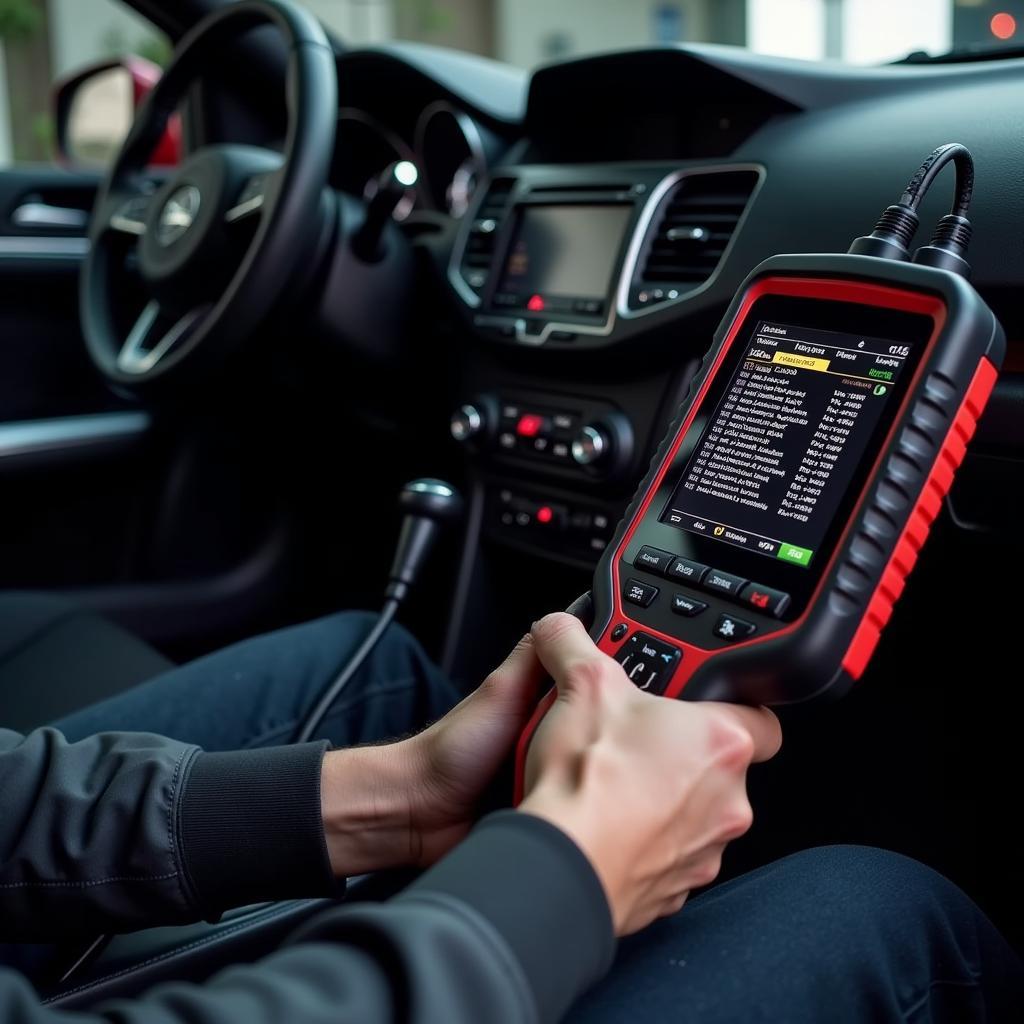Long Term Fuel Trim (LTFT) is a crucial parameter your car’s Engine Control Unit (ECU) uses to adjust the air-to-fuel ratio for optimal engine performance and fuel efficiency. Simply put, LTFT readings reflect how much the ECU is adjusting the fuel mixture to compensate for deviations from the ideal air-fuel ratio (14.7:1) over a longer period.
Understanding LTFT readings can be your first line of defense in diagnosing various engine problems and ensuring your vehicle runs smoothly. This article provides a deep dive into Car Diagnostic Ltft, explaining its significance, how to interpret its readings, common causes of LTFT issues, and troubleshooting tips.
What is LTFT in Car Diagnostics?
As mentioned earlier, LTFT stands for Long Term Fuel Trim. It represents the percentage of change the ECU makes to the fuel injectors’ pulse width to maintain the optimal air-fuel mixture.
 LTFT Graph
LTFT Graph
Think of it this way: if your car’s engine is running lean (too much air, not enough fuel), the LTFT will show a positive value, indicating the ECU is adding more fuel to compensate. Conversely, a negative LTFT value suggests a rich condition (too much fuel, not enough air), and the ECU is reducing fuel delivery.
How to Read Car Diagnostic LTFT
You’ll need an OBD-II scanner to access your car’s LTFT readings. Once connected, you can usually find the LTFT values displayed as a percentage. Most vehicles have separate LTFT readings for Bank 1 (cylinder bank containing cylinder #1) and Bank 2 (for V-type engines).
Here’s a general guideline for interpreting LTFT readings:
- LTFT within +/-5%: This range generally indicates a healthy fuel system with no significant issues.
- LTFT between +/-5% to +/-10%: Minor issues might be present. Further investigation is recommended.
- LTFT exceeding +/-10%: This indicates a potential problem requiring immediate attention.
Keep in mind that these are just general guidelines. The ideal LTFT range can vary slightly depending on the vehicle make, model, and operating conditions.
Common Causes of High LTFT Readings:
Several factors can contribute to high (positive) LTFT readings, including:
- Vacuum leaks: Leaks in the intake manifold, vacuum hoses, or brake booster can disrupt the air-fuel ratio, leading to a lean condition.
- Faulty Oxygen Sensor: A malfunctioning oxygen sensor can send inaccurate readings to the ECU, causing incorrect fuel trim adjustments.
- Dirty or clogged fuel injectors: Obstructed fuel injectors can restrict fuel flow, resulting in a lean mixture.
- Low fuel pressure: Insufficient fuel pressure can also lead to a lean condition.
Common Causes of Low LTFT Readings:
Low (negative) LTFT readings can be caused by:
- Clogged air filter: A restricted air filter can choke the engine, leading to a rich fuel mixture.
- Faulty Mass Air Flow (MAF) sensor: An inaccurate MAF sensor reading can mislead the ECU into delivering too much fuel.
- Leaky fuel injectors: Leaking injectors can cause excess fuel to be injected into the combustion chamber, resulting in a rich condition.
- High fuel pressure: Excessively high fuel pressure can also lead to a rich mixture.
Troubleshooting Car Diagnostic LTFT Issues
 OBD2 Scanner Diagnosis
OBD2 Scanner Diagnosis
Diagnose and resolve LTFT issues by addressing the underlying problem. Here’s a step-by-step approach:
-
Read the Diagnostic Trouble Codes (DTCs): Use your OBD-II scanner to check for any stored DTCs, which can provide valuable clues about potential issues.
-
Inspect for Vacuum Leaks: Check all vacuum hoses and the intake manifold for any cracks, leaks, or loose connections.
-
Inspect the Air Filter: Ensure the air filter is clean and not clogged. Replace it if necessary.
-
Check Fuel Pressure: Use a fuel pressure gauge to verify if the fuel pressure is within the manufacturer’s specifications.
-
Test the Oxygen Sensors: Inspect the oxygen sensors for damage and test their functionality. Replace faulty sensors.
-
Inspect and Clean Fuel Injectors: Have the fuel injectors professionally inspected and cleaned or replaced if needed.
-
Test the MAF Sensor: Check the MAF sensor for contamination and test its functionality.
-
Seek Professional Help: If you cannot pinpoint the problem or the issue persists after attempting these steps, it’s best to consult a qualified mechanic.
Conclusion
Understanding car diagnostic LTFT is paramount for maintaining optimal engine performance, fuel efficiency, and the overall health of your vehicle. By monitoring LTFT readings, you can proactively identify potential issues and address them before they escalate into major problems.
While this guide provides a comprehensive overview of car diagnostic LTFT, remember that diagnosing and fixing car problems often require specialized knowledge and tools. Don’t hesitate to seek professional help when needed.
FAQs about Car Diagnostic LTFT
1. What is a good LTFT reading?
Ideally, LTFT readings should be within +/-5%. However, slight variations may occur depending on the vehicle and operating conditions.
2. Can I drive my car with a high or low LTFT?
While driving short distances with minor LTFT deviations might be possible, it’s not recommended. Persistent high or low LTFT values indicate underlying problems that can worsen over time, impacting engine performance, fuel economy, and emissions.
3. What is the difference between STFT and LTFT?
Short Term Fuel Trim (STFT) reflects immediate adjustments the ECU makes to the fuel mixture, while LTFT represents long-term adjustments based on driving history.
4. Can a bad battery cause LTFT problems?
While a weak battery might not directly cause LTFT issues, it can lead to erratic ECU behavior and inaccurate sensor readings, indirectly affecting fuel trim.
5. How often should I check my car’s LTFT?
It’s good practice to monitor your car’s LTFT periodically, ideally every few thousand miles or during regular maintenance checks.
Need further assistance with car diagnostics?
Contact us via WhatsApp: +1(641)206-8880 or Email: [email protected]. Our team of car diagnostic experts is available 24/7 to help you with all your car diagnostic needs.

Leave a Reply